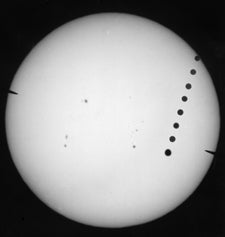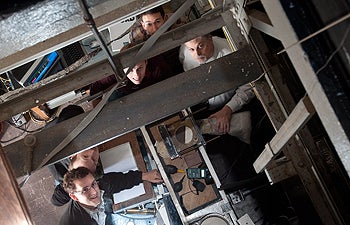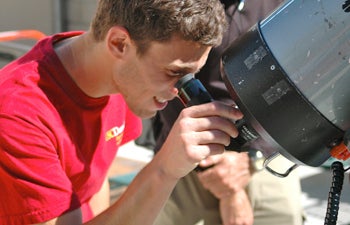Black Pearls of the Sun
Atop Mt. Wilson overlooking Pasadena, dozens of stargazers peered through telescopes at a celestial wonder. A few people donned T-shirts declaring “I Witnessed the Transit of Venus.”
To mark the event that won’t occur again for another 105 years, a couple was married with a wedding party carrying spinning pinwheels reflecting the sun, catching glimmers of gold.
Amid the hoopla, USC Dornsife astronomer Edward Rhodes gathered with some of his students inside the 60-foot solar tower he operates, quietly explaining that the ancient Greek word “planetos” means “wanderer.”
Early scientists understood planets to be celestial bodies orbiting a star. Some planets — such as Venus — would show retrograde motion and appear to back up for a while and that was thought to be wandering.
“That’s why the Greeks and Babylonians referred to planets as gods and attributed godlike powers to them,” Rhodes said, adding that in Greek mythology, Helios was the Titan god of the sun.
So in the case of the June 5 transit of Venus across the sun, consider if you will, that a hockey puck has been hit across the white-hot surface of Helios. That would be Venus making its rare appearance across the face of the sun. Because Venus’ orbit is tilted 3.4 degrees compared to Earth’s, only four transits occur every 243 years.

USC Dornsife astronomer Edward Rhodes and his students captured images of the transit of Venus across the sun at Mt. Wilson Observatory’s 60-foot solar tower. Since the sun set before the transit was complete at Mt. Wilson, the dots which are Venus in this composite image do not span across the entire sun. Composite by Jie Gu.
For the six-hour transit, Rhodes’ USC Dornsife students, and Shawn Irish, a USC data analyst and daily operator of the 60-foot tower, took photos of the unfiltered sun with the Ellerman camera every 30 minutes.
“To me as a scientist, it’s really cool to see a little dark dot plodding its way across the sun, and that’s a planet, that’s Venus,” said Matthew Orr, a junior majoring in astronomy in USC Dornsife and astronautical engineering at USC Viterbi School of Engineering.
Each day since 1984, Rhodes and his team have recorded such images of the sun’s front hemisphere at the tower. A pioneer in the field of solar physics, Rhodes began conducting research at Mt. Wilson’s 60-foot tower in 1977, as a California Institute of Technology postdoctoral fellow. In 1984, and now a USC professor, Rhodes became the principal investigator of projects at the 60-foot solar tower, built by solar astronomer George Ellery Hale, who in June 1908 used it to become the first to detect the sun’s magnetic fields.
On June 5, Irish and the students took their positions at the telescope’s camera every 30 minutes and after a loud “wap!” of the shutter, another image was captured.
“As a student, it’s remarkable to be part of this historical narrative that is modern science,” said Orr, a recipient of the Barry M. Goldwater Scholarship. “Great discoveries have come out of the Venus transit.”
Orr added that in 1716, astronomer Edmund Halley first proposed a method for calculating Earth’s distance from the sun by using the transit of Venus. With the discovery, Halley established the absolute scale of the solar system from Kepler’s third law. The 1761 and 1769 expeditions to observe the transits of Venus gave astronomers their first real value for the sun’s distance.
Now, scientists use transits to find planets outside our solar system, known as extrasolar planets or exoplanets, Rhodes said. Exoplanets are too distant and dim to be viewed directly, but when one passes in front of its parent star, it blocks a tiny bit of the star’s light.
Scientists analyzing the changing light in stars can identify the presence of a planet, and determine the planet’s size, temperature and atmospheric composition.
“When planetary scientists who are measuring regular starlight suddenly see a dip in brightness that means a transit has occurred,” Rhodes said. “The idea is to try and convert the magnitude of the dip to some estimate of the area of the little circle obscuring the light. If you can get that estimate then you can try to estimate the radius, thus the size of the exoplanet. They’re trying to detect the range of the sizes of exoplanets.”
During the transit, the group also took a pair of digital photos each minute using a narrowband filter and an electronic camera. These images will provide measurements of the intensity of the solar disk before and during the transit so that the amount of dimming that Venus caused can be calculated for comparison with the dimming introduced during stellar transits by extrasolar planets.
Taking the research a step further, transits may help scientists detect so-called Goldilocks Zones, or areas of space in which a planet is just the right distance from its home star, so that its surface is neither too cold nor too hot.

USC Dornsife’s Edward Rhodes (far right) and his team inside Mt. Wilson Observatory’s 60-foot solar tower.
“The discussion has shifted from just discovering exoplanets to discovering Earth-like planets,” Rhodes said. “Ultimately, the idea is to find evidence of habitability — or better yet evidence of life somewhere else.”
Stephen Pinkerton, a third-year Ph.D. graduate student of physics and astronomy, was revved up about the transit for those reasons and the sheer rarity of the event.
“As far as Venus transits go, it’s the last one in any of our lifetimes,” he said.
Travis de Ronde, who earned a degree in physics in May 2012, said conducting research on Mt. Wilson can feel surreal.
“The telescope we’re using is more than 100 years old,” de Ronde said. “It’s the one George Hale used to discover magnetic fields. We’re on a mountain where Edwin Hubble proved the galaxy was expanding.”
Eric Hotchkiss, a senior majoring in math and physics in USC Dornsife and mechanical engineering in USC Viterbi, wasn’t disappointed that after all the anticipation, Venus looked like a black dot.
“We didn’t expect rainbows to be dancing across the solar disc,” Hotchkiss said.
Meanwhile, undergraduates in Rhodes’ Astronomy 100 class watched the transit from a telescope set up on University Park campus. Joseph Vandiver, laboratory manager for USC Dornsife’s Department of Physics and Astronomy, and Anthony Spinella, a USC Viterbi graduate student who in 2009 earned his bachelor’s degree in physics in USC Dornsife and has been a data analyst for Rhodes ever since, assisted students while Rhodes was on Mt. Wilson.

Daniel Ben-Zion, a junior majoring in physics in USC Dornsife, takes his turn at the telescope where he witnessed the transit of Venus. Photo by Ben Pack.
Daniel Ben-Zion, a junior majoring in physics in USC Dornsife, and Elly Glavich, a senior at USC Thornton School of Music, were among those waiting in line at the telescope.
“I feel so privileged to see something that won’t happen again for more than 100 years,” Glavich said.